NEPTUNE
Dan Electro Guitars & Basses
Updated 22
April 2006

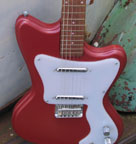
Danelectro Jizzblaster:
This is the stuff we're making at the Ranch. German carved perimeter -- like
Moserite -- opaque white Rickenbacker-ish pickguard. New-old stock '64 neck. Wide and thick, with
Brazilian rosewood fretboard and Gibson jumbo fretwire. Of course, Subway custom wiring with
series parallel and phaze reversal. We've made alot of these over the years, for people like Mark
Knopfler and Robert Cray Band. In our shop this is known as the Mark Knopfler model. $$400 --
and its a deal at that.
For 25 years, Subway Guitars has been synonymous with Dan Electro guitars and basses. We always
have a large stock of Dan Electro guitars, basses, and baritones. The 2-pickup instruments
include Subway custom wiring (series/ parallel & in/out of phase). All have custom brass
intonated saddles and sealed gears.
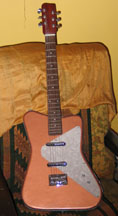
Pro I:
Some patient guy requested this. We made it in
a real 50s style, including the pickguard from a 1950s kitchenettte tabletop made of real mother
of toiletseat. Long scale, Subway custom wiring, adjustable bridge and good gears -- with a
355-type of tone block running down the center. New/old stock neck blank.$500

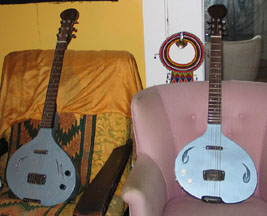
Sitar Twins
Sreco from Slovenia, who plays sitar,
built a bunch of these on my ranch and they are really wild! -- with sound holes and an ebony
"buzz" bridge. The peghead is styled like a 3D gourd. Where else could you get a left-handed
sitar for $500?
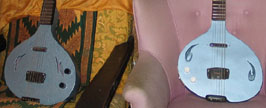
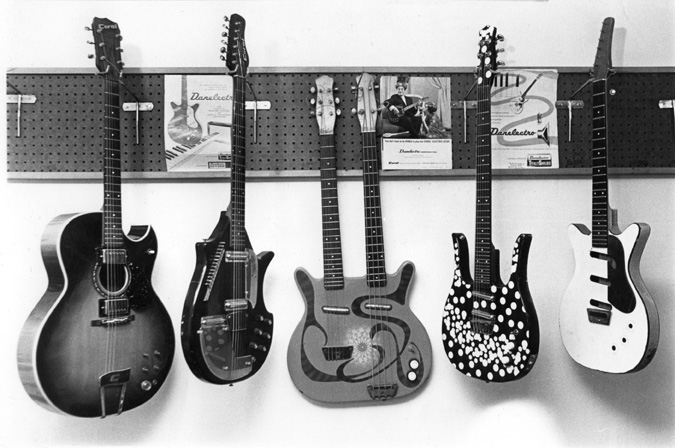
Freaky collection of Fatdog's Danos -- circa 1968
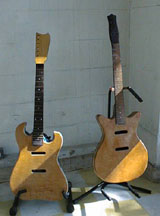
Another one of Fatdog's bird'seye-topped Danelectros
According to Fatdog:
"Some fat customer was having a fit in front of the store; he jumped (repeatedly) on top of his
guitar body and walked away. What'd I do? I peeled off the masonite fragments and put on a
beautiful bird'seye top with sound block, and topped it off with a long-scale Silvertone
Danelectro neck." Shown alongside: the Jimmy Page re-do with a bird'seye top, a new/old stock neck
blank and rosewood peghead veneer.

Longhorn Trio

New/old stock Neptune Pager
An example of Subway re-manufacturing from
50s or 60s parts from the original Neptune, New Jersey Danelectro hall. About 20 years ago, we
liquidated thousands of great Danelectro parts and have been putting together custom instruments.
We've developed standard Subway upgrades: we use better gears and a good adjustable
bridge. I've worked out a wiring system, utilizing push-pull pots that give original and extra
voicings to these Danelectros. One of the features -- which was influenced by D'Angelico -- was a
25 inch scale length on a thick, Brazilian rosewood board fretted with really good jumbo wire. The
necks are really solid and have dual trussrods. They really sustain.
The old masonite,
hollow bodies just have this thing about them.... Its the proper arrangement of molecules in the
cosmos. Some guy in Florida wanted us to recreate one that we made for Jimmy Page years ago; this
is what he got. For $500 we can make hundreds more of these, with any type of pickups or
doodads or knick-knacks -- as we've been doing for years.
The new import models are
decent and have stayed with a Danelectro philosophy and tradition of budget-oriented instruments,
but there really is a difference with this old, USA stuff.
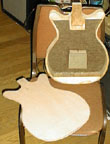
Custom Danelectro Project in progress
using old Danelectero
stuff
I'm building some custom guitars I thought I'd show you. These illustrate a
typical Subway process. There's alot of old, screwed up Danelectro convertibles
from the 50s
and 60s -- caved in, bad custom work, whatever. In this scenario
we're taking two of these
instruments and making a fancy Jimmy Page-style guitar.
First, we're replacing the masonite top with a thicker, bird'seye maple top.
Note the block
glued into the body. That will be under the bridge. We're
making one right-handed and one
left-handed.
 These instruments will have two tube pickups with the Subway custom wiring --
These instruments will have two tube pickups with the Subway custom wiring --
which is a
volume and tone with push-pull pots, one for series parallel mode and
one for in-phase or
out-of-phase. These are the KILLER sounds that you get out
of classic Danelectros.

Now for the necks
Years ago, we bought thousands of
unfinished parts that were the remains of
Danelectro's Neptune (New Jersey) facility. This
was the stuff from the 50s
and 60s with Brazilian rosewood, slab fretboards and dual
trussrods. The necks
are a bigger profile. From these blanks we've constructed hundreds of
custom
instruments and have shaped them to the customer's hand.
You'll see four pieces. One had the peghead grafted on at Danelectro, probably
in the 50s.
Then you'll see one with no peghead (peghead stub), which is the
way some of them came. We
can put any shape we want on them and have made
even Vox-style and other peghead profile
necks out of them.
Another one you'll see shows my coke-bottle peghead with a Brazilian rosewood veneer. In the 60s
Danelectro used alot of Brazilian rosewood pegheads, and since I love the look of the wood, I do
this just for my own traditional interest.
The last one shows the walnut veneer over the back of the peghead, for extra strength. What's
interesting is you see the stripe down the center of the neck where the quarter-round router bit
did the first shaping pass in the Danelectro factory. The rest we do by hand -- rasping and
sanding.
On top of a thick rosewood fretboard, Danelectro used a really good jumbo fret wire, which we
crown and polish.
The guitars are completed with upgraded appointments, such as a non-trem strat bridge and
high-quality tuning gears, which allows the instrument to play in tune and STAY in tune. The
sound block under the bridge cuts back on any feedback and gives it a great 335-style tone -- good
for blues and funk.
Another interesting point is: working with these instruments for 34 years, every now and then
people trade a piece in that I worked on, or Mike Stevens, or Lary Jamison worked on in the 60s.
We just love the customizing of these guitars.
Below you'll see other Danelectro custom creations from the past years.

Two Danelectros


Proof of Life -- still alive -- Danelectro!
The REAL
50s look. It's George Jetson's guitar. Re-created using new/old stock, Neptune parts and some
good improvements. Features: Brazilian rosewood fretboard, Brazilian peghead, genuine 50s
vintage mother-of-toiletseat pearloid veneer for pickguard. My favorite wiring: series parallel
switch and phaze reversal switch.

Baritone Jizzcaster
You can actually
cast jizz on the baritone voicing. Super cool, compact and stylish. Utilizes old Danelectro
parts and the Subway custom touch. Wicked! $425.

Dan Electro Baritone
I was shipping this
Dan Electro baritone to a dude in New Mexico and remembered I had my personal one in the shop. I
thought I'd put up this image of a couple of Dan Electro baritones that we've made tons of for
years using a bunch of new/old stock parts. $400-$450
...And a few more pixs of Spring 2002 projects in progress:

Dan Electro Custom Jimmy Page (lefty)

Fatdog Working the Neck
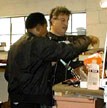
Freddie Roulette and Fatdog
makin' it "just
so"...

Levitating Project

Finished neck
Subway Custom Dan Electro baritone. 4x2 peghead, lipstick tube in the neck position.
Telecaster* bridge and pickup. Strings 20 thru 80. Push-pull phaze. $450
Dan
Electro Jimmy Page. Black. $500
Copper Dan Electro 6-string bass. Shorthorn,
one pickup. Clean. $525
Subway Custom Dan Electro baritone. 4x2 peghead, lipstick
tube in the neck position. Telecaster* bridge and pickup. Strings 20 thru 80. Push-pull phaze.
$450
Dan Electro Jimmy Page. Black. $500
Copper Dan Electro 6-string
bass. Shorthorn, one pickup. Clean. $525
Single cutaway: (Les Paul shape) 2
pickup, six-in-line peghead.
Silvertone/Dan Electro: 2-pickup, long-scale,
"red sparkle burst" or black sparkle (amp in case)
Silvertone/Dan Electro
solid body: (Jizz Master) 2-pickup, red/black sunburst. Other colors available
Pro
1: with custom-fitted, long-scale neck
Baritone/6-string bass: 15-fret bass
neck, convertible body, 1 pickup. Other variations available

The Dan E Jizzcaster
If Jimmy hadn't wanked on
*Strats, these guitars would have been the "classic" for that single coil blues and
rock tone. Dan Electro and Coral made these jizzcasters in alot of different configurations in the
60s. Some were dressed with the Silvertone label to be vended through Sears; others with the Dan
Electro name; later on they beveled the sides of the body to an elliptical flying saucer shape and
bore the Coral name. They are a great guitar in the Fender® style; they had a thick Brazilian
rosewood fretboard, two or three lipstick tubes and a fixed or whammy bar bridge. The whammy was
really weak and sucked for tuning. When we got the Dan E pile, there were tons of parts for these;
we are recreating the two- and three-pickup model with some improvements. The necks came finished
with the skate-key tuners. We're using a six-way non-trem strat* bridge, and Gotoh or
Kluson-style tuners. We're doing the alligator-skin crackle finishes -- mostly because they're
fairly non-toxic and also reminiscent of the 60s Dan Electro era. We'll probably do some weird
colors, but we'll stain the wood -- like purples, blues and greens. We're adding a push-pull pot
for phaze reversal. These things KILL for $400. We've sold alot of them over the years to
top R&B players that just couldn't believe what a great guitar they are.
Baritone/6-string bass: "Jizz Master " shape, 1 pickup
12-string
solid body: 2 pickup "Jizz Master " shape
Bellzouki 12-string teardrop
body: 1 pickup, brown sunburst
Electric sitars: Dan Electro 1 pickup, brown
sunburst, solid body, gourd shape
Longhorn bass: 2 pickup, baby-blue re-finish.
Others in stock
Long-scale 2-pickup " *Jazz Bass": solid body
(Sherrif Mike Stevens model)
Coral Firefly NOS parts $400
Danelectro
baritone $425
Emerald green Danelectro Les Paul USA $475
Copper
Danelectro Jimmy Page 2 pickup USA $500

DanE Jizzcaster
Baddest boy in town. Long-scale
Brazilian. Wide fretboard. Two tubes in series - parallel with phaze. $600
Black Daneleectro Jimmy Page 2-pickup $500
Danelectro Jizzcaster solid body
$400
50's baby-blue Danelectro longhorn $800
Black new/old stock 60s
Danelectro longscale dual tube. Badest boy in town. $600
Dan Electro baritone.
Formica top convertible 30" scale length. One lipstick p-up. $400
Coral
longhorn bass-Hagstrom. 2X2 neck, Hag HB. $300
Dan Electro 50s 6-string longhorn.
Baby-blue refin, 24-fret, stacked pots. $1000

Electric Sitar
Similar to Dan-E. Buzz yur brains out. This really
works. $400
* Fender®, Strat® and Jazz Bass® are all registered trademarks of the
Fender Musical Instrument Corporation.
FatDog's Dedication to Dan Electros
An historical perspective, spiced with talk
of new hybrids to come.
During the mid-60s in Berkeley, the players were: Randy Prune (aka Randall Smith), formerly of
Prune Music; Larry Jameson and Sheriff Mike Stevens of later Fender® Custom Shop and Steven's
Guitar fame. The somewhat hippy aesthetic of the time was to take the non-traditional instruments
and modify, recycle, tweek, and customize them into something really cool and useful. And this has
been part of what Subway's been about for the last 30 years.
Enter another guru --
Moosie, Mark Silber. He was another die-hard Dan Electro fan. He would always go "What's this
thing about Stratocasters*? These Dan Electros have tone forever!" He always would be
coming up with really weird and bizarre Dan Electro stuff to swap in the big wheel of weird
guitars in Berkeley. He also always thought the old Dan Electro tube amps killed.
After
Randy Prune and his partner, Dave, left Berkeley for Mill Valley, Larry Jameson and Mike Stevens
moved into their North Berkeley shop and store. I had been working with Larry and he was a big fan
of Dan Electros. He had this thing of putting a Dan Electro in a tuxedo. And in those days, a Dan
E would sit on the rack for a big $40. And maybe a customized one might go for $80-$100. A few
years ago somebody traded in a Dan E they got from us in the late 60's that was tuxedo-ized and
had a tele bridge and tele pickup in it. My old pal, Joe Gore, flipped when he saw it, borrowed
it, and I think I'm going to need a crowbar to py it out of his hands.
Sheriff Mike
Stevens played in some country and western band and traded me a busted up little Martin for my
longscale Dan Electro solid body bass. He repainted it ivory and just loved the sucker. He loved
the tone. He swore by it, even when he could have made anything he wanted in the Fender®
Custom Shop. I'm sure he still played that thing. He's probably still playing it. He always was a
big advocate of Dan Electro stuff.
I remember even injuring my back, lifting this
incredible redwood burl onto the bandsaw to slice a filet to laminate on the top of a Dan Electro.
Another thing we'd do would be to find curley maple classical guitar backs and glue them on top of
the masonite, bind and sunburst them. There's a bunch of this floating around; it reappears and
gets traded in here -- its really cool. A contemporary Dan Electro purist, though, would shudder
and cringe at these things.
Subway has always been a center for the Dan Eelctro thing.
And I remember in the mid-70s we printed a whole bunch of Dan Electro t-shirts -- that's that
image you're seeing up above. There was only one way to get them: you had to be a Dan Electro
owner and player. And there was no charge. Money didn't talk, in this case. The dude was a
cariacature of Link Ray playing a longhorn created by John Seabury . We even had bumper stickers
made up that said: "Dan Electro: Guitar of the Stars!" and "Dan Electro
Forever!" -- which was a satire on the auto culture's "flatheads forever!"
After getting quite a name for these things, everybody was coming to us to trade in Dan Electros
and Dan Electro parts. When Ralph Novack worked at Subway in the 70s, he came up with the
retro-brass Dan Electro bridge saddle idea and some of the modified Dan Electro wiring that we
use.
What most people don't realize about Dan E's is that macho isn't better. The soul
of the Dan Electro sound comes actually from mid-impedience pickups. They're among the few
instruments that have them in series when both pickups are on. One of our things is to throw in a
push-pull pot for phaze reversal. Another thing we've done is used a series parallel switch so
that both pickups are on all the time, with the option of being in- or out-of phaze. We've come up
with a bunch of standard wiring modifications to make them function better. The stock gears and
bridge are total dookie. Not only does the guitar not stay in tune, but with that wooden slat, the
intonation is wacked. The notes will start to play sharp as you go up the fretbaord.
In
the 70s Dan Electros were still considered a joke by many. Piles of parts started emerging and
becoming available to us from the people who liquidated the factory. As far as I know, the three
people I worked with over the years were Cecil Gulickison, who lived in Florida and made this
primodial guitar synthesizer. He bought alot of the Dan Electro necks and bodies to put his pickup
on, since the guitar in thos days was an integral part of the synthesizer.
Then there was
Lou Rose. He's probably how I'll end up: a wild guitar-obsessed old man. He's a guitar
builder-luthier himself. He could see the value of all this stuff when it came up for liquidation.
Believe it or not, if you told somebody you were going to pay $1.00 each for hundreds of Dan
Electro necks and bodies, they'd be making an appointment for you at the shrink -- or calling 911
to order the right sized straitjacket. But Lou ended up with a huge pile of this stuff.
Then there was Tony Mark. I don't know much about him, but he had some of the stuff. I sold him
more stuff so he could make his budget guitar line that he did in the 80s. W ended up with over
4000 necks and bodies. Somewhere in the 80s, Guitar Player did a few features on the
archeological essence of these Dan Electros that we kept un-earthing.
Tiesco del Ray,
known to some as the guitar organist, Dan Forte, really got into the Dan Elecertro thang and often
expounded their merits in his column, "Off the Wall," which most people still think was
the only decent column in that magazine for years. He told me one time he was in a pawn shop
trying to buy a Dan Electro bass and was telling the owner "Aw, that's just a budget slab of
masonite -- its not worth that much!" Then the owner went back and produced a copy of the
Guitar Player story, written by Tiesco himself, promoting Dan Electros and cool guitars. He
had to pay a higher price becauseof his own article. The whole time the pawn shop owner didn't
recognize him or know who he was. That's irony.
As far as tone goes, years ago in the
"Quest for Elmo" tone, Ry sent me a photo of Elmo James playing a old Kay guitar and
some unknown amp that you could only see a little section of the control planel of. I immediately
recognized it and sent a 2-12 Dan Electro guitar amp to him. I still remember the phone call, and
his voice: "This things's got the TONE! I've spent thousands and thousands, trying to get
this sound! And here it just arrives at my house in a funky cardboard box as a gift."
We got weird-ass prototypes that you would just look at and shake your head. We got some
early Dan Electros, like imagine a non-cutaway, masonite guitar in a green zolatone. Imagine a Dan
Electro Jizzcaster that had beveled edges, but was a thinline with an f-hole. An some of the
weirder ones have these huge trap doors in the back that took great big 67-1/2 volt red and black
radio batteries. They even had a tube in the circuit.
Somewhere in a pile that he
obtained was the prototype of whatwas then known as the Jimmy Page model. One time when he was
around we thought he should own it, so he ended up with it. In the future, I'm going to try to get
some photos of this stuff up for everyone out there to see.
What we're up to now, since
Dan E has become kosherized, is putting together runs of weird guitars using alot of new/old stock
parts from the 50s and 60s. We're also retro-manufacturing some of the missing parts.
Right now Sketch is building a series of jizzcaster bodies, done in a crackle finish, similar to
what Dan Electreo used. If you look at "Custom Creations" on our site, you'll see alot
of the guitars we've been making for years, using new/old stock Dan Electro parts.
We've
arranged them in hybridized, mutant creations in ways that nobody ever dreamed of. The Dan Electro
gods are sizzling and quaking at our basphemy. Our mandocello uses these short-scale neck blanks
with an 8- 10-holed peghead, mounted onto a longhorn body. Our mariachi bass uses the huge L-5
guitar body witha short-scale bass neck. The countless baritones we've made often took the dorkey
convertible body with the short-scale bass neck. We're going to make a bunch of solid body
12-strings and 2-3 pickup jizzcasters. All for bargain prices.
If you're into E's --keep
your eyes on this spot. We're going to start listing all sorts of retro- and weird creations for
sale.
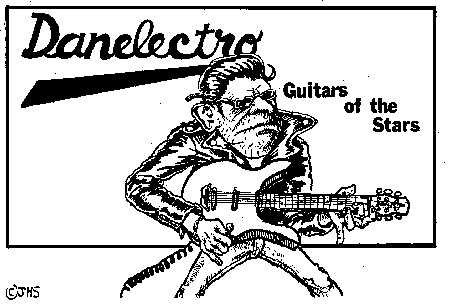
A guy called up once and told of his dad working at an army base in New Jersey (electronic
engineering division). He said alot of technicians lost their security clearance for failure to
take McCarthy's loyalty oath and Nat Danials hired them. He said when he was a boy, these new Dan
E workers still visited his dad, who kept his job at the base, and brought over kinky, weird
electric guitars they were developing.
As I mentioned earlier about prototypes: once a teenager from New Jersey called up and wanted to
know if I was interested in these weird Dan E guitars that he and his mom found while cleaning out
their basement. Of course I bought them. And I bet his dad was one of those fired army
electronic engineers.
Fatdog
Ramblings With Masonite
The first time I set my paws to a Danelectro was 1968 jn the back hall of Randy Prune's store. Randy became Randall Smith of Mesa Boogie. Prune Music was a '60s Berkeley vision of a used music shop. Its back hall was one step from the trash. He showed me a Masonite curiosity accompanied by a fiberglass Supra a la the White Stripes. He gave me the Supra and I left the Masonite for someone else. Prune eventually moved and was replaced by Guitar Resurrection. Sales and repairs were run by Larry Jameson and his pal Mike Stevens (who went on to work in Fender's Custom Shop). There we put "Danelectros in tuxedos," as Larry used to say. He was a large influence on my obsession with these proletarian guitars. We souped up Silvertones, put Fender and humbucking pickups in Danelectros, refinished them, upgraded their gears and bridges. The commune of Berkeley's music clientele were hippy musicians like Country Joe MacDonald, Creedence Clearwater, Santana, Sons of Chaplin, Moby Grape, Dan Hicks and Terry Garthwaite's Joy Of Cooking.
Larry's old school sign painting career gave him a creative eye, superb craftwork and a daring touch. He'd take a guitar to the bandsaw and reshape it like a barber drastically changing someone's hairstyle. We'd be awestruck when he'd cut away a Gibson L5 or a Super 400. Once he scored a stack of flame maple classical guitar backs he started overlaying and binding anything solid, including Danelectros. Beautiful sunburst longhorns and U2s resulted. Mike Stevens once swapped me something for a long scale solid-body Danelectro jazz bass. When he was done with it, it had become a cream and black gem, an object of real beauty. Over the years, even in Fender's custom shop, he would call me and marvel at how awesome his bass still was. One time, Howard Klepper and I were carrying a huge 2X14 foot slab of oak for a Danelectro body which was to be overlaid with a veneer of redwood burl. It slipped from his hands and my back still remembers it four decades later.
Now it's 1972. Enter the Moose, a.k.a. Mark Silber, just back from Tangier. He was the dude that was King of old axes. His old Greenwich; village store was legendary for 30's Martins, Gibsons and Everything cool that was played in the 60's. People made pilgrimages to see his- inventory of banjos, mandolins, old guitars and curiosities, myself included. He left for North Africa in 1968, and when he came back to Berkeley four years later we bonded over Danelectros. We swapped and traded all sorts of masonite and poplar. One time I found a Dano in the Berkeley dump, half in the mud like a fossil. I refurbished it and still play it today.
In the mid seventies Ralph Novak restored and tuxedoed some Danelectros. During the punk heyday in the San Francisco area, Danelectros, Voxes and Supros were in, and we were the ones with the goods. Most needed improvements in wiring, gears or bridge to be up to pro standards. It's ironic; I didn't at all like the punk sound or philosophy, being a jazz, latin and blues listener, but the movement, fad and its sound really put us on the map, and made me the long green.
Nat Lane had a huge store on 3rd Ave and lllth St. in New York, and for reasons unknown gave me hundreds of weird and demented guitars which I sold and then sent him payments. This inventory gave me the goods and notoriety. Bands like the Psychotic Pineapple, Dead Kennedys, Lucky Stiffs and the Rubinoos played and popularized these Danelectros and offbeat guitars. Eric Drew Feldman of Captain Beefheart and NRBQ and Jesse Colin Young played longhorn basses. John Seabury, rock artist, musician and cartoonist glamorized these guitars in band posters and Subway adds.
In '83 came the big explosion or disaster. Lou Rose music in Edison New Jersey salvaged thousands of Danelectro parts and couldn't find a buyer. He lucked onto me, and after a little negotiating I received about four thousand new old stock Danelectro necks, bodies and parts. This became fodder for the Subway crew to chomp into. All sorts of mutations sprouted up; one of a kind mutts or formulated new models were created. The parts included: two Danelectro pickup winders, unopened boxes of pickup tubes from Bridgeport Mills destined to be drugstore lipstick caps, templates and routing jigs, control plates, wiring harnesses and knobs. If you were a guitar builder or into Danelectros, you would flip out and faint just from opening these cartons. Guitar Player Magazine wrote a few articles and photographed some of these artifacts.
We turned out obscene baritones, 12 string solid-bodies, mando-cellos, sitar-creations, nine-strings, teardrop and fiddle basses, righty and lefty fireflys; we made a lefty Firefly model for the guitarist of Operation Ivy, now of Rancid, and he loved it so much he got four more. The ultra loud feedback vibrated them apart onstage. The word was out. Cecil Gulickson in Florida had previously bought a huge inventory to convert to his Condor Guitar synthesizer. His project flopped and he sold his pile to me. Tony Mark of New York Oty sold and traded a huge stash of oddball necks and bodies to me. Then I got a call leading to the most bizarre Danelectros ever. A kid in New Jersey said his dad worked for a local guitar company and had a lot of unidentifiable stuff in his basement. I said send it out, well evaluate it and pay. When that shit came in, I was in awe. My jaw dropped and I almost keeled over. Guitars with big trapdoors in the back, with sixty-seven and one-half volt batteries built in and tubes, non cutaway Ul with Zoloton, pre-lipstick tube pickups that had a molded, casted cover, three-pickup amp and case models, thinline beveled Hornets, Jizzblasters with elliptical bodies, the Jimmy Page prototype which I later gave to him.
Over the years there've been many imitations of the Danelectro style, some of them flattery on the verge of theft. There was an Italian-made sixties longhorn with a copper sunburst and faux-lipstick tubes called the Dynelectron. Hondo in Japan made a longhorn bass-and-guitar-lin. Saint-Louis Music / Ampeg made some series-l0 longhorns and Jimmy Page styles. Silvertones were actually made by Danelectro for Sears. The '60's Coral bodies made in Japan were built into some weird guitars. Jerry Jones made high-quality replicas of Danelectros, as did the Evets Corporation in this century.
There were stories of Nat Daniels hiring electronic technicians from the army base near Neptune, New Jersey that didn't pass the security requirements or refused the Loyalty Oath from the McCarthy era. These became some of his workers in design and assembly. My love for Nat's creations derives from the proletarian perspective he developed working at Epiphone with D' Angelico. It's a mindset and an aesthetic that in making quality electric guitar, it's the parts that matter, the hardware and electronics, the junction of neck and body. The finish and decorative body woods are fairly unimportant to the fabric of the instrument. We've seen guitars of metal, marble, plastic, triple-A flamed maple, all of which can influence the voice of the instrument somewhat but are of secondary importance. Scale length, fret-accuracy, fretboard wood, encapsulated, shielded electronics and good bridges are more fundamental to the tone. That said, there's nothing I like more than a grave-robbed Frankenstein guitar, and I really dug Nat's inventiveness, his willingness to experiment leading to 6-12 doublenecks, the electric sitar, the guitarlin, a thirty-one fret guitar and mandolin. He had a real diverse imagination and an eye for design.
My outrageous accumulation of Dano stock aside, the '80s were a time of pointy metal dreckschticks, and '50's and '60's stuff wasn't happening. In the nineties a hint of retro was in, and we started remanufacturing Vox teardrop guitars and basses using a hodgepodge of these parts. Out came Mando-cello longhorns which multi-instrumentalists like Ry Cooder, David Lindley, Jackson Browne, Billy Bragg and Tysco Del Ray added to their arsenal of sounds. We made a baritone for Polly Harvey that she-loves. Charlie- Hunter's mom worked at subway in the m1d-70s as a repair tech, and later on I made Charlie his first seven string jazz guitar. That inspired me to cobble together Danelectro stuff to create the seven string "Hunt" model, an L5 sized archtop with a round hole.
I've continued making a six-string version of that guitar which Taj Mahal loves, called the Maestro model, a 17" acoustic-electric jazz box reminiscent of a Howard Roberts Epiphone, all from '60's parts. The FD-30., a tribute to Grant Green, is an ES-33-0 style: guitar made from Firefly components and, P90 pickups. Larry Craven is building solid body Florentine mando-cellos from old short scale necks. Srecho Papic, a Sloventan sitar player, built 00 hollow-body sitars using Danelectro stuff. I recently crafted some long-scale Pro-l's, adding a- mother of toilet-seat pearloid '50's tabletop for the pickguard. We made a baritone Pro-l for Cheap Trick.
At some point we started experimenting with custom wiring and eventually developed our Subway wiring system. We utilize two push-pull pots; the volume has a series-parallel switch on it, the tone has phase-reversal. Traditional Danelectros use both pickups in series, like a humbucker with the coil . separated at the neck and bridge, and this gives them their unique voice, blending the harmonics across a wide divide of string length. Our wiring keeps the simple zen aesthetic but allows a new wealth of tonal modes.
Today, Jizzblasters are the thing. Six-strings, twelves, baritones. The're solidbody Danelectros using new old stock necks and a German carve around the top. We do a variety of finishes ranging from tasteful stains to grotesque Van Goghian gobs of paint. We get commissions for all sorts of hybridizations of new and old, like Jizzblasters with Bigsby trems, and P-90s mixed with humbuckers in front of tele bridges.
It never ceases to amaze me how much Danelectros continue to resonate with multiple generations of musicians. Some are drawn by the funky vintage look, some by the now irreplaceable Brazilian-rosewood fretboards on broad, parallel-truss-rod necks. Some Dano afficionados are devotees of the peculiar lipstick tube tone; some want one just because that's what Mark Knopfler or Jimmy Page played. Really, it's a combination of all of the above, a cheeky blend of functionality and mojo. Check out www.fatdawg.com and click on the little dog saying, "Pull my paw," and you'll see what it's all about.
Woof, Arf, and Bow-Wow,
Fatdog
PERSPECTIVE on Dan Electro
Now I'm going to talk to you about "the disease."
After being in the guitar business for 30 years, recently we have observed a
"disease." It has to do with "stock." Some of it is valid, when you're dealing with old Gibson
and Fender® and Gretsches, etc., from the 50s. But it has nothing to do with this whole
realm of proletarian generic vintage guitars -- i.e., Kays, Harmonys, Silvertones, Dan Electros.
These guitars were manufactured on the budget level and had really dookie appointments. If the
tuning gears worked for 5 years, it would be remarkable. Most of them had non-adjustable bridges,
so soon as you start playing up the neck, the notes would go sharp.
The thing with icon and fashion pieces with old guitars has to do with how happy people are with
their peckers. Recently, they put out the new boner pill, Viraga; this should help most people
with this problem. But, PLEASE don't take this disease and apply it to guitars like Dan
Electros.
Making a compensated brass saddle allows the guitar to play in tune, up and down the neck.
Putting tuning gears on that actually tune allows the guitar to actually work as a musical
instrument. Modifying the wiring to get the original sounds -- and then some -- expands the voice
of the guitar.
For 30 years we've been taking these type of instruments that are for budget-minded people and
making them work much better. We bought thousands of Dan Electro necks and bodies; when we
assemble them, we actually make them into decent instruments.
FatDog
Ordering Merchandise
I understand your concerns about buying a guitar over the Internet. You can't put your hands on
it. You don't know what it'll look like, what it'll sound like, how it will feel. Then there are
the issues surrounding shipping anxiety: "Will it arrive undamaged?" "When will it arrive?"
"WILL it arrive?" The concerns go on and on: "What's the tracking number?" "Will you ship it
today?" "When will you ship it?" "Can I get it tomorrow?"
Here are five key
points to put your mind at ease:
- Your purchase will definitely arrive in good, undamaged condition AND in a timely
manner.
- Your purchase is insured against damage in transit.
- If you don't like what you've ordered, you can return it within two weeks of purchase.
- You have the option of a full CASH refund or a trade-in for something else you like. All you
pay is the return shipping, which amounts to about $10 within the Continental United
States.
- You just can't lose.
Policy
"Experience Ecstacy" for a week with your new guitar. If the instrument is not what you
expected, then expect a full refund on merchandise returned in the condition of purchase. Fatdog
considers this the backbone of good biz (and happy customers).
NOTE: There
is no refund for shipping.
Trade-ins are seriously considered at a high value.
Subway Guitars
1800 Cedar Street
Berkeley, California 94703
(510)
841-4106
noon til six, Monday thru Saturday
Pacific Time

HOME











 These instruments will have two tube pickups with the Subway custom wiring --
These instruments will have two tube pickups with the Subway custom wiring -- 













